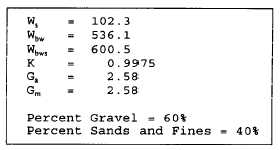IN ANSWERING QUESTIONS 13-39 THROUGH
13-42, REFER TO FIGURE 13-B.
13-39.
What percentage of the material
tested passed the No. 40 sieve?
1.
17.9%
2.
11.3%
3.
10.2%
4.
2.7%
13-40.
What is the percentage of error in
13-41.
13-42.
13-43.
the soil sample?
1.
1.5%
2.
1.4%
3.
0.15%
4.
0.14%
The soil sample predominantly
consists of what type of material?
1.
Cobbles
2.
Gravel
3.
Sand
4.
Fines
What is the percentage of
contained in the sample?
1.
48.3%
2.
51.7%
3.
62.5%
4.
88.7%
gravels
A sieve analysis data sheet shows
that the original weight of a test
sample exceeds the total weight of
fractions,
resulting in a
percentage error that is smaller
than the maximum permissible
error.
Which of the following
actions should you take?
1.
Disregard the value of the
error
2.
Rerun the test
3.
Add the value of the error to
the largest amount retained by
any sieve
4.
Add the value of the error to
the smallest amount retained
by any sieve
13-44.
When is it necessary to prewash a
sample before proceeding with a
normal dry sieve analysis?
1.
When the sample contains a
surplus of superfine materials
2.
When the sample has an
undesirable water content
3.
When the sample is too dry
4.
When the sample contains too
little superfine materials
13-45.
13-46.
During a sieve analysis, 2% of the
material passed the No. 200 sieve.
What subsequent test, if any,
should you perform on the sample
to determine this soil’s
susceptibility to frost?
1.
Hydroscopic moisture content
2.
Hydrometer analysis
3.
Specific gravity
4.
None
After a sieve analysis has been
performed, which of the following
materials should be tested for
specific gravity of solids?
1.
Only those larger than the
No. 40 sieve
2.
Only those retained on the
No. 4 sieve
3.
Only those passing the No. 4
sieve
4.
Materials passing the No.
sieve
200
Figure 13C
IN ANSWERING QUESTIONS 13-47 AND 13-48,
REFER TO THE DATA IN FIGURE 13C.
13-47.
Find the specific gravity of
solids.
1.
2.67
2.
2.69
3.
2.71
4.
2.73
13-48.
Find the composite specific
gravity.
1.
2.42
2.
2.52
3.
2.62
4.
2.64
93

